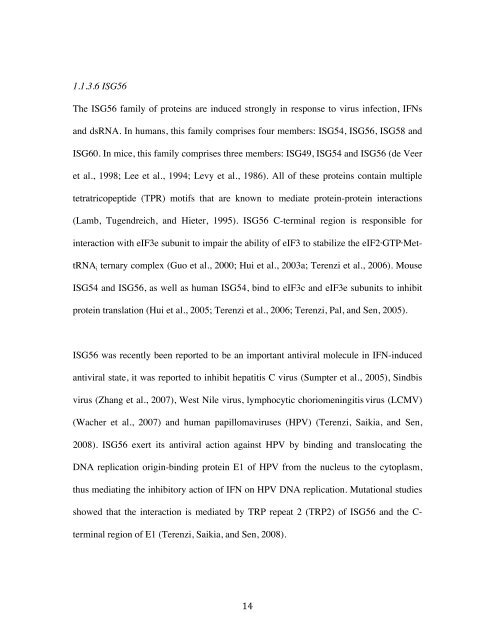Han Xiao PhD thesis - Research@StAndrews:FullText - University of ...
Han Xiao PhD thesis - Research@StAndrews:FullText - University of ...
Han Xiao PhD thesis - Research@StAndrews:FullText - University of ...
Create successful ePaper yourself
Turn your PDF publications into a flip-book with our unique Google optimized e-Paper software.
1.1.3.6 ISG56<br />
The ISG56 family <strong>of</strong> proteins are induced strongly in response to virus infection, IFNs<br />
and dsRNA. In humans, this family comprises four members: ISG54, ISG56, ISG58 and<br />
ISG60. In mice, this family comprises three members: ISG49, ISG54 and ISG56 (de Veer<br />
et al., 1998; Lee et al., 1994; Levy et al., 1986). All <strong>of</strong> these proteins contain multiple<br />
tetratricopeptide (TPR) motifs that are known to mediate protein-protein interactions<br />
(Lamb, Tugendreich, and Hieter, 1995). ISG56 C-terminal region is responsible for<br />
interaction with eIF3e subunit to impair the ability <strong>of</strong> eIF3 to stabilize the eIF2·GTP·MettRNA<br />
i ternary complex (Guo et al., 2000; Hui et al., 2003a; Terenzi et al., 2006). Mouse<br />
ISG54 and ISG56, as well as human ISG54, bind to eIF3c and eIF3e subunits to inhibit<br />
protein translation (Hui et al., 2005; Terenzi et al., 2006; Terenzi, Pal, and Sen, 2005).<br />
ISG56 was recently been reported to be an important antiviral molecule in IFN-induced<br />
antiviral state, it was reported to inhibit hepatitis C virus (Sumpter et al., 2005), Sindbis<br />
virus (Zhang et al., 2007), West Nile virus, lymphocytic choriomeningitis virus (LCMV)<br />
(Wacher et al., 2007) and human papillomaviruses (HPV) (Terenzi, Saikia, and Sen,<br />
2008). ISG56 exert its antiviral action against HPV by binding and translocating the<br />
DNA replication origin-binding protein E1 <strong>of</strong> HPV from the nucleus to the cytoplasm,<br />
thus mediating the inhibitory action <strong>of</strong> IFN on HPV DNA replication. Mutational studies<br />
showed that the interaction is mediated by TRP repeat 2 (TRP2) <strong>of</strong> ISG56 and the C-<br />
terminal region <strong>of</strong> E1 (Terenzi, Saikia, and Sen, 2008).<br />
<br />
14
















